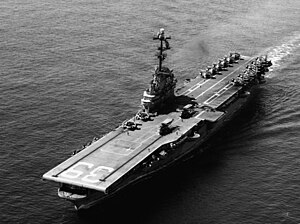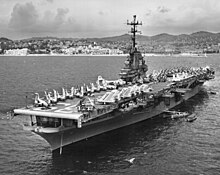
USS Shangri-La (CV/CVA/CVS-38) was one of 24 Essex-class aircraft carriers completed during or shortly after World War II for the United States Navy.

USS Essex (CV/CVA/CVS-9) was an aircraft carrier and the lead ship of the 24-ship Essex class built for the United States Navy during World War II. She was the fourth US Navy ship to bear the name. Commissioned in December 1942, Essex participated in several campaigns in the Pacific Theater of Operations, earning the Presidential Unit Citation and 13 battle stars. Decommissioned shortly after the end of the war, she was modernized and recommissioned in the early 1950s as an attack carrier (CVA), eventually becoming an antisubmarine aircraft carrier (CVS). In her second career, she served mainly in the Atlantic, playing a role in the Cuban Missile Crisis. She also participated in the Korean War, earning four battle stars and the Navy Unit Commendation. She was the primary recovery carrier for the Apollo 7 space mission.

USS Intrepid (CV/CVA/CVS-11), also known as The Fighting "I", is one of 24 Essex-class aircraft carriers built during World War II for the United States Navy. She is the fourth US Navy ship to bear the name. Commissioned in August 1943, Intrepid participated in several campaigns in the Pacific Theater of Operations, including the Battle of Leyte Gulf.

USS Kearsarge (CV/CVA/CVS-33) was one of 24 Essex-class aircraft carriers completed during or shortly after World War II for the United States Navy. The ship was the third US Navy ship to bear the name, and was named for a Civil War-era steam sloop. Kearsarge was commissioned in March 1946. Modernized in the early 1950s as an attack carrier (CVA), she served in the Korean War, for which she earned two battle stars. In the late 1950s she was further modified to become an anti-submarine carrier (CVS). Kearsarge was the recovery ship for the last two manned Project Mercury space missions in 1962–1963. She completed her career serving in the Vietnam War, earning five battle stars.

USS Ault (DD-698) was an Allen M. Sumner-class destroyer in the United States Navy. She was named for Commander William B. Ault, air group commander aboard Lexington. Commander Ault was declared missing in action on 8 May 1942 after leading an air attack in the Battle of the Coral Sea and was posthumously awarded the Navy Cross for his action in the battle.

USS Randolph (CV/CVA/CVS-15) was one of 24 Essex-class aircraft carriers built during World War II for the United States Navy. The second US Navy ship to bear the name, she was named for Founding Father Peyton Randolph, president of the First Continental Congress. Randolph was commissioned in October 1944, and served in several campaigns in the Pacific Theater of Operations, earning three battle stars. Decommissioned shortly after the end of the war, she was modernized and recommissioned in the early 1950s as an attack carrier (CVA), and then eventually became an antisubmarine carrier (CVS).

USS Wasp (CV/CVA/CVS-18) was one of 24 Essex-class aircraft carriers built during World War II for the United States Navy. The ship, the ninth US Navy ship to bear the name, was originally named Oriskany, but was renamed while under construction in honor of the previous Wasp (CV-7), which was sunk 15 September 1942. Wasp was commissioned in November 1943, and served in several campaigns in the Pacific Theater of Operations, earning eight battle stars. Like many of her sister ships, she was decommissioned shortly after the end of the war, but was modernized and recommissioned in the early 1950s as an attack carrier (CVA), and then eventually became an antisubmarine carrier (CVS). In her second career, she operated mainly in the Atlantic, Mediterranean, and Caribbean. She played a prominent role in the manned space program, serving as the recovery ship for five Project Gemini missions: Gemini IV, Gemini VI, Gemini VII, Gemini IX, and Gemini XII. She was retired in 1972, and sold for scrap in 1973.

USS Antietam (CV/CVA/CVS-36) was one of 24 Essex-class aircraft carriers built during and shortly after World War II for the United States Navy. The ship was the second US Navy ship to bear the name, and was named for the American Civil War Battle of Antietam (Maryland). Antietam was commissioned in January 1945, too late to serve actively in World War II. After serving a short time in the Far East, she was decommissioned in 1949. She was soon recommissioned for Korean War service, and in that conflict earned two battle stars. In the early 1950s, she was redesignated an attack carrier (CVA) and then an antisubmarine warfare carrier (CVS). After the Korean War she spent the rest of her career operating in the Atlantic, Caribbean, and Mediterranean. From 1957 until her deactivation, she was the Navy's training carrier, operating out of Florida.

USS Meredith (DD-890), a Gearing-class destroyer, was the fourth ship of the United States Navy to be named for the United States Marine Corps Sergeant Jonathan Meredith, who saved the life of Lieutenant John Trippe of Vixen, during the Barbary Wars. The destroyer was laid down at the Consolidated Steel Corporation at Orange, Texas, on 27 January 1945; launched on 28 June 1945, sponsored by Miss Juliette S. Kopper, great-great-great-grandniece of Sergeant Meredith; and commissioned on 31 December 1945.

USS Manley (DD-940), named for Captain John Manley (c.1733–1793), was a Forrest Sherman-class destroyer built by the Bath Iron Works Corporation at Bath in Maine. The keel was laid down on 10 February 1955. Manley was commissioned on 1 February 1957 and sponsored by Mrs. Arleigh A. Burke, wife of then Chief of Naval Operations, the principal speaker at the commissioning ceremonies.

The third USS Luce (DLG-7/DDG-38) was Farragut-class guided missile destroyer of the United States Navy that served from 1962 until discarded in 1992. The ship was named for Rear Admiral Stephen B. Luce (1827–1917). Luce was sold for scrapping in 2005.

USS Joseph P. Kennedy Jr. (DD-850) is a former United States Navy Gearing-class destroyer. The ship was named after Lieutenant Joseph P. Kennedy Jr., a naval aviator, son of the former U.S. Ambassador to Britain, Joseph P. Kennedy Sr., and older brother of future President John F. Kennedy. Joseph P. Kennedy Jr. served, with interruptions for modernization, until 1973. Among the highlights of her service are the blockade of Cuba during the Cuban Missile Crisis and the afloat recovery teams for Gemini 6 and Gemini 7. Joseph P. Kennedy Jr. is on display as a museum ship in Battleship Cove, Fall River, Massachusetts. She was added to the National Register of Historic Places in 1976, and designated a National Historic Landmark in 1989 as one of a small number of surviving Gearing-class destroyers.

USS Ingraham (DD-694) was a United States Navy Allen M. Sumner-class destroyer, the third ship in U.S. Navy history to be named for Duncan Ingraham. She was in commission from 1944 to 1971. Following her US service, she was sold to the Hellenic Navy and renamed Miaoulis. The ship was sunk as a target in 2001.

USS Wallace L. Lind (DD-703), was an Allen M. Sumner-class destroyer of the United States Navy.

USS James C. Owens (DD-776), an Allen M. Sumner-class destroyer, is the only ship of the United States Navy FRAM II class to be named for Lieutenant James C. Owens Jr., a member of Torpedo Squadron 8 on board USS Hornet. His entire squadron was lost in an attack against Japanese aircraft carriers 4 June during the Battle of Midway. Lt. Owens received the Navy Cross and the Presidential Unit Citation (US) posthumously.

USS Kenneth D. Bailey (DD-713/DDR-713) was a Gearing-class destroyer in the United States Navy during World War II. She was named for Kenneth D. Bailey. The name Kenneth D. Bailey was originally assigned to the destroyer escort USS Kenneth D. Bailey (DE-552) on 30 November 1943; DE-552 was cancelled on 10 June 1944, and the name was reassigned to DD-713 on 8 July 1944.

USS Holder (DD/DDE-819) was a Gearing-class destroyer of the United States Navy, the second Navy ship named for Lieutenant (jg) Randolph Mitchell Holder, a Navy pilot who was killed during the Battle of Midway.

The third USS Lloyd Thomas (DD/DDE-764) was a Gearing-class destroyer in the United States Navy during the Korean War and the Vietnam War.

The third USS William C. Lawe (DD-763) was a Gearing-class destroyer of the United States Navy.

USS Noa (DD-841) was a Gearing-class destroyer of the United States Navy, the second Navy ship named for midshipman Loveman Noa (1878–1901).




























